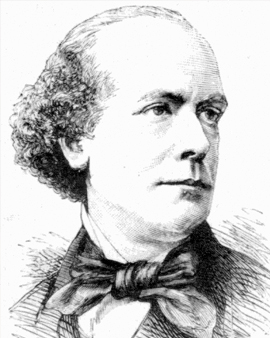Political satire is basically as old as politics itself - think of Sophocles in ancient Greece or the jesters in Shakespeare's "King Lear". As a Briton under Queen Victoria, anyone who wanted to indulge in the latest social or even political mockery usually demanded the "punch" from 1841 onwards. The cover picture with the British counterpart to Punch came from the pen of Richard Doyle, who also made some of the first "cartoons".
As the younger son of a caricaturist and portrait painter, Richard Doyle was born into this art. At the age of twelve he is said to have illustrated Homer with mocking pictures. His talent became known at an early age - he worked with the caricaturist John Leech from 1840; Doyle's clients included the novelists John Ruskin, William M. Thackerey and Charkes Dickens. It should be noted that before the age of photography, many novels were illustrated with drawings, woodcuts or steelcuts. Good authors demanded good illustrators; this is one of the reasons why first editions of literary classics are so valuable today.
In 1843 Doyle became a full-time illustrator at the "Punch". Its founder, Henry Mayhew, was committed to social reform - he is still known in professional circles for his extensive statistical research on the situation of impoverished workers and craftsmen in Britain - and called for a mouthpiece for everything that was not right in the Victorian age. The journal, with its novel "cartoons" (drawn picture stories), spread rapidly, and Richard Doyle played a major part in it.
But Doyle was not only a mocker with crayon, but also - as his Irish family name suggests - a devout Catholic. When the punch criticized Pope Pius IX's change of policy (Pius, at first a liberal reformer, changed to a conservative course in reaction to the revolution of 1848), Doyle resigned in 1850 and turned back to book illustration, especially of fairy tales and sagas. His last major work was the collection of drawings, which were written by Andrew Lang and published in 1884 as "The Princess Nobody".
Richard Doyle did not live to see the success of this invisible princess: in 1883 he died of a stroke. By this time his former companions, Charles Dickens as a writer and "The Punch" as a satirical magazine, had long since written literary and media history.
×





.jpg)
.jpg)
 - (MeisterDrucke-158054).jpg)
 - (MeisterDrucke-158054).jpg)
.jpg)
.jpg)
.jpg)
.jpg)
.jpg)
.jpg)
.jpg)
.jpg)
_-_(MeisterDrucke-387264).jpg)
_-_(MeisterDrucke-387264).jpg)
_-_(MeisterDrucke-1053579).jpg)
_-_(MeisterDrucke-1053579).jpg)
.jpg)
.jpg)
.jpg)
.jpg)
.jpg)
.jpg)
.jpg)
.jpg)
.jpg)
.jpg)
_-_(MeisterDrucke-387274).jpg)
_-_(MeisterDrucke-387274).jpg)
.jpg)
.jpg)
 - (MeisterDrucke-282848).jpg)
 - (MeisterDrucke-282848).jpg)
.jpg)
.jpg)
.jpg)
.jpg)
 - (MeisterDrucke-225882).jpg)
 - (MeisterDrucke-225882).jpg)
.jpg)
.jpg)
.jpg)
.jpg)
.jpg)
.jpg)
.jpg)
.jpg)
.jpg)
.jpg)
.jpg)
.jpg)
_-_(MeisterDrucke-387834).jpg)
_-_(MeisterDrucke-387834).jpg)
.jpg)
.jpg)
.jpg)
.jpg)
.jpg)
.jpg)
.jpg)
.jpg)
 - (MeisterDrucke-55154).jpg)
 - (MeisterDrucke-55154).jpg)
_a_cheval_sur_un_oiseau_mouche_Illustration_tiree_de_In_F_-_(MeisterDrucke-1350824).jpg)
_a_cheval_sur_un_oiseau_mouche_Illustration_tiree_de_In_F_-_(MeisterDrucke-1350824).jpg)
 - (MeisterDrucke-54264).jpg)
 - (MeisterDrucke-54264).jpg)
_-_(MeisterDrucke-387273).jpg)
_-_(MeisterDrucke-387273).jpg)
.jpg)
.jpg)
_-_(MeisterDrucke-387257).jpg)
_-_(MeisterDrucke-387257).jpg)
 - (MeisterDrucke-101187).jpg)
 - (MeisterDrucke-101187).jpg)
_-_(MeisterDrucke-1108376).jpg)
_-_(MeisterDrucke-1108376).jpg)
.jpg)
.jpg)
.jpg)
.jpg)
.jpg)
.jpg)
.jpg)
.jpg)
.jpg)
.jpg)
.jpg)
.jpg)
_-_(MeisterDrucke-1117765).jpg)
_-_(MeisterDrucke-1117765).jpg)
.jpg)
.jpg)
.jpg)
.jpg)
.jpg)
.jpg)
.jpg)
.jpg)
.jpg)
.jpg)
.jpg)
.jpg)
.jpg)
.jpg)
.jpg)
.jpg)
.jpg)
.jpg)
.jpg)
.jpg)
_-_(MeisterDrucke-387272).jpg)
_-_(MeisterDrucke-387272).jpg)
.jpg)
.jpg)
.jpg)
.jpg)
_-_(MeisterDrucke-387277).jpg)
_-_(MeisterDrucke-387277).jpg)
.jpg)
.jpg)
_-_(MeisterDrucke-1354547).jpg)
_-_(MeisterDrucke-1354547).jpg)
_-_(MeisterDrucke-1131184).jpg)
_-_(MeisterDrucke-1131184).jpg)
.jpg)
.jpg)
.jpg)
.jpg)
.jpg)
.jpg)
.jpg)
.jpg)
_-_(MeisterDrucke-1054318).jpg)
_-_(MeisterDrucke-1054318).jpg)
.jpg)
.jpg)
.jpg)
.jpg)
_-_(MeisterDrucke-387271).jpg)
_-_(MeisterDrucke-387271).jpg)
 with Robert Devereux 2nd Earl of Essex in council 1586 (cartoon print) - (MeisterDrucke-212080).jpg)
 with Robert Devereux 2nd Earl of Essex in council 1586 (cartoon print) - (MeisterDrucke-212080).jpg)
.jpg)
.jpg)
.jpg)
.jpg)
.jpg)
.jpg)
.jpg)
.jpg)
.jpg)
.jpg)
_-_(MeisterDrucke-1322439).jpg)
_-_(MeisterDrucke-1322439).jpg)
.jpg)
.jpg)
_and_Francis_I_of_France_(1494-1547)_at_the_Field_of_the_C_-_(MeisterDrucke-212082).jpg)
_and_Francis_I_of_France_(1494-1547)_at_the_Field_of_the_C_-_(MeisterDrucke-212082).jpg)
_-_(MeisterDrucke-387278).jpg)
_-_(MeisterDrucke-387278).jpg)
.jpg)
.jpg)
.jpg)
.jpg)
.jpg)
.jpg)
_-_(MeisterDrucke-387265).jpg)
_-_(MeisterDrucke-387265).jpg)
.jpg)
.jpg)
_and_the_Dwarves_par_Doyle_Richard_(1824-1883)_-_(MeisterDrucke-941621).jpg)
_and_the_Dwarves_par_Doyle_Richard_(1824-1883)_-_(MeisterDrucke-941621).jpg)
.jpg)
.jpg)
.jpg)
.jpg)
_-_(MeisterDrucke-1061450).jpg)
_-_(MeisterDrucke-1061450).jpg)
.jpg)
.jpg)
_-_(MeisterDrucke-387276).jpg)
_-_(MeisterDrucke-387276).jpg)
.jpg)
.jpg)
.jpg)
.jpg)
_-_(MeisterDrucke-387268).jpg)
_-_(MeisterDrucke-387268).jpg)
_-_(MeisterDrucke-387267).jpg)
_-_(MeisterDrucke-387267).jpg)
.jpg)
.jpg)
.jpg)
.jpg)
.jpg)
.jpg)
.jpg)
.jpg)
.jpg)
.jpg)






